Disclaimer: the S1R and S2R were provided for testing by Olight free of charge
The S1R and S2R are the latest additions to Olight's popular rechargeable EDC Baton series. They are almost identical in their user interface and output, but the S1R uses a RCR123 (16340) and the S2R a 18650 lithium ion battery. This translates to a clear difference in size, weight and runtimes.
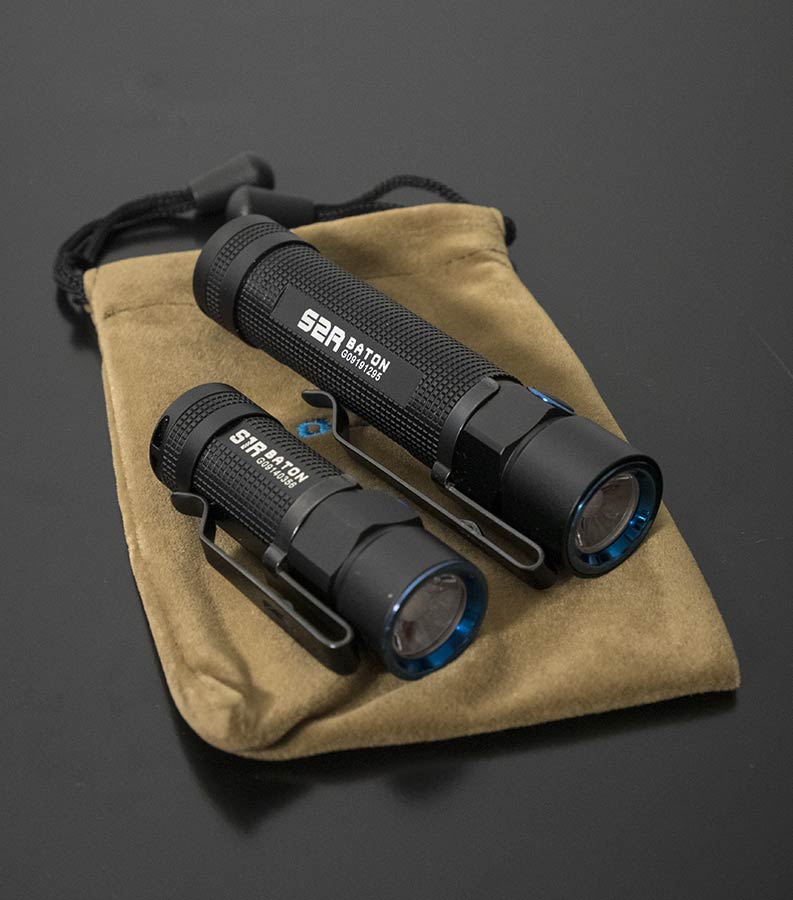
The S1R tested here is the newest revision with the Turbo and Turbo S mode. The previous version only had the 900 lumen Turbo mode, which is now called Turbo S. The new Turbo mode is rated at 600 lumens.
The lights available to purchase from Olight's webstore
Features and manufacturer's specifications
S1R
Battery: RCR123/16340, a high drain protected 550mAh IMR battery provided
LED: Cree XM-L2 in cool white
Waterproof: IPX8
Impact resistance: 1.5m
Mode memory: yes, except turbo and turbo s
Other: magnet in the tailcap
Output specs
Maximum output: 900 lumens for 1.5 minutes, stepdown to 300 lm
Other output levels: 600/300/60/12/0.5 lumens
Light intensity: 5250 candela
Beam distance: 145 m
Measured dimensions and weight
Length: 66.3mm
Head width: 21.1mm
Handle width: 19.5mm
Weight: 49g with the bundled battery
S2R
Battery: 18650, a protected 3200mAh battery provided
LED: Cree XM-L2 in cool white
Waterproof: IPX8
Impact resistance: 1.5m
Mode memory: yes, except turbo
Other: magnet in the tailcap
Output specs
Maximum output: 1020 lumens for 2 minutes, stepdown to 500 lm
Other output levels: 500/120/12/0.5 lumens
Light intensity: 5800 candela
Beam distance: 153 m
Measured dimensions and weight
Length: 104.9mm
Head width: 23.1mm
Handle width: 21.6mm
Weight: 97g with the bundled battery
User interface
Other than the Turbo S mode on the S1R the UI is similar. Both can be locked out physically with a twist of the tailcap.
From off:
Single click turns the light on with the last used mode memorized (except for turbo and turbo s)
Long press activates moonlight
Keeping the switch pressed engages electronic lockout mode where the light cannot be accidentally switched on
Double click activates turbo
Triple click activates strobe
From on:
Single click turns the light off
Double click activates turbo, another double click on the S1R activates turbo s
Long press cycles modes (low, medium, high)
Triple click activates strobe
Double click and hold activates shutdown timer 3/9 minutes
The lights come in a plastic packaging, which showcases them in a floating manner.





They come bundled with:
Pouch
Lanyard
User manual
USB charger with a magnetic base
Battery

The batteries are proprietary Olight branded ones, which can be charged right in the light. I measured the RCR123 at 564mAh / 2.01Wh at 0.5A down to 2.8V and the 18650 at 3137mAh / 16.0Wh at 1.0A down to 2.8V
They both have a protection circuit, which activates when running the flashlights unattended. The lights run them below 2.5 volts, since I couldn't trip the protection when manually discharging the batteries to 2.5V. The bundled USB charger can reset the battery protection just fine and the protection was also easy to reset with the SkyRC MC3000 charger.
Batteries are inserted to the light the positive end facing the tailcap. The charging system requires a proprietary system where both the negative and positive terminals are located at one end of the battery.

The magnetic USB charging cable is super easy to use as the light snaps in place without any aiming required.

There was a bit of variation in the charging current between the two chargers bundled with the lights. The other one charged at 0.75 and the other at 0.80 amps. The final resting voltage after removing the charger was also a bit different, 4.18V vs. 4.23V. Both within spec. However, I feel 0.8A (0.95A at 4.20V ignoring DC-DC losses) is a bit high for the RCR123. The S1R battery is charged in about one hour, while the 18650 in the S2R takes just shy of five hours.
Charging the S1R
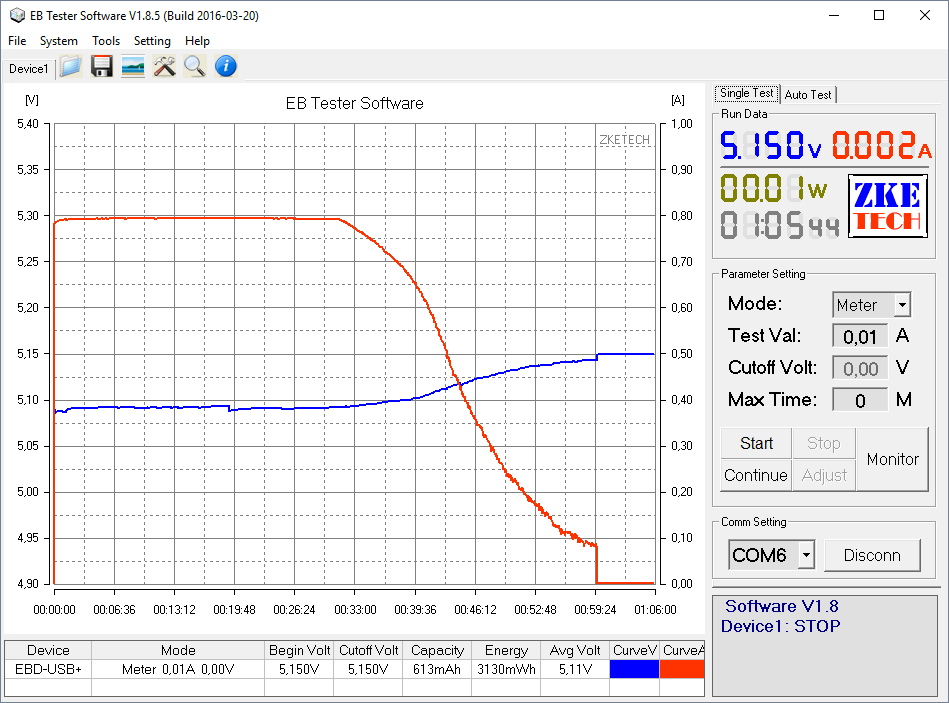
Charging the S2R
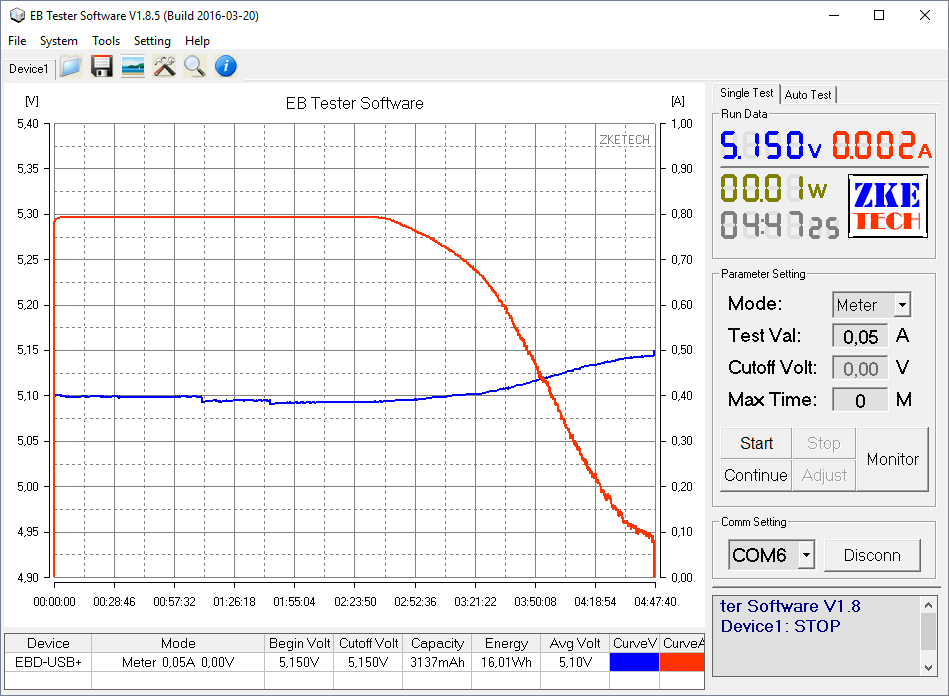


Olight S1-Cu (RCR123), Olight S1R (RCR123), Olight S10 (RCR123), Olight S2R (18650), Olight S2A (2x AA)
Beam and tint
The S1R and S2R use a similar emitter/optics combo to the previously tested S1A and S2A. Therefore their beam pattern is identical. Just like with the S1A and S2A I measured some visible differences in the color temperature and tint between the emitters in the S1R and S2R. As is usual in mass produced flashlights, some samples may be more neutral in color than others.
Because of the optics, the beam is very large and defined with much dimmer spill than with lights that use reflectors. The tint shift between the hotspot and the spill is also much smaller than in Cree lights with reflectors. For close to medium range work the beam is very useful.


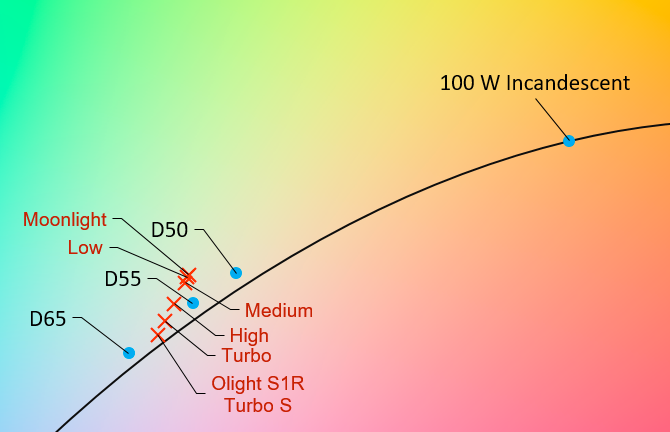
S1R tint in different brightness modes.

S1R tint in different parts of the beam. My sample was very nice and neutral without any green or magenta

S2R tint in different brightness modes.

S2R tint in different parts of the beam. The S2R however was a bit greenish. There are small areas in the beam that have a cooler temperature, which is represented with the "Spill 3" mark.
Spectral data and color rendering
For spectral information and CRI calculations I use an X-rite i1Pro spectrophotometer with HCFR, Babelcolor CT&A and ArgyllCMS spotread for the graphs and data. For runtime tests I use spotread with a custom script and an i1Display Pro because it doesn't require calibration every 30 minutes like the i1Pro.
Explanation of abbreviations (click link to read more)
CCT = correlated color temperature, higher temperature means cooler (bluish)
CRI (Ra) = color rendering index consisting of 8 different colors (R1-R8), max value 100
CRI (R9) = color rendering index with deep red, usually difficult for led based light sources, max value 100
TLCI = television lighting consistency index, max value 100
CQS (Qa) = Proposed replacement for CRI, RMS average of 15 color samples
CRI2012 (Ra,2012) = Another proposed replacement for CRI, consists of 17 color samples
MCRI = Color rendering index based on the memory of colors or 9 familiar objects
NEW Read more about the IES TM-30-15 method here (link is external)
TM-30 = The newest color rendering method using 99 samples. Preferred for comparing LEDs.
TM-30 (Rf) = Accuracy of colors, fidelity index. Replaces CRI(Ra).
TM-30 (Rg) = Gamut of colors, saturation index. Higher number means more saturated colors.
Tint dev. ("Duv" in the CTA screenshots) is the tint's distance to the black body radiator line in the CIE graphs. The higher the number, the greener the tint. 0,0000 means absolutely neutral white and negative numbers mean rosy/magenta tint. Anything over 0,0100 can be described as visibly green.
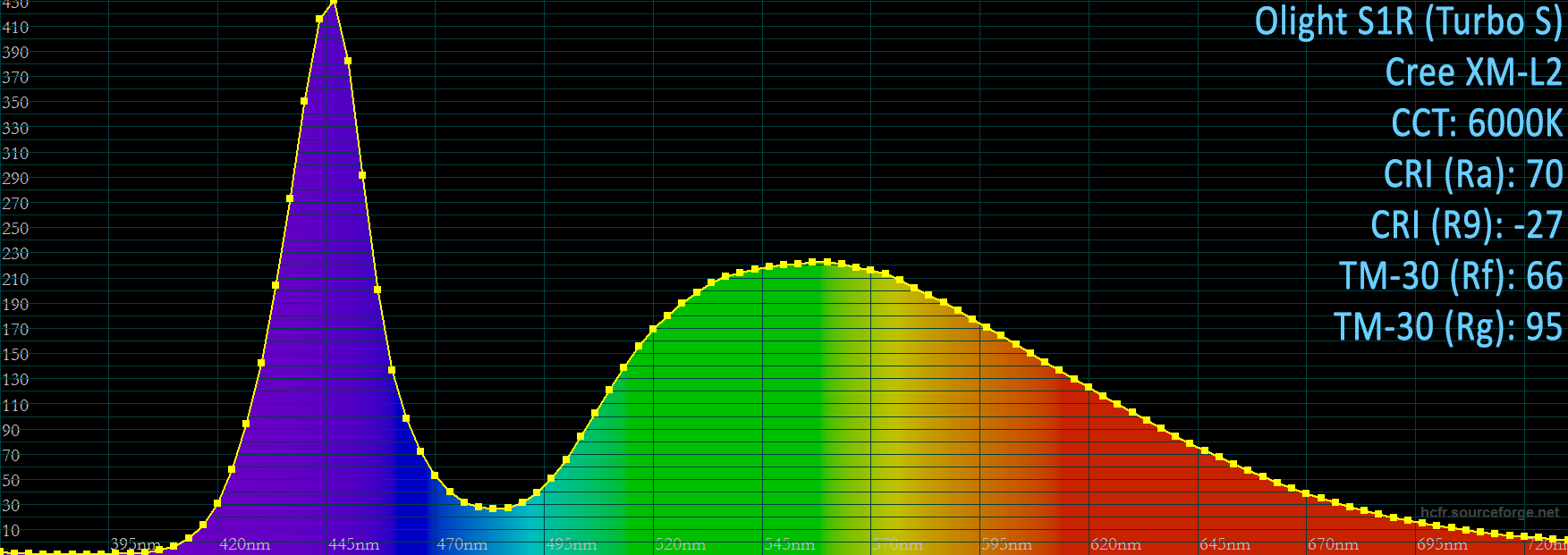
S1R spectral graph.

S2R spectral graph.

S1R CRI data.

S2R CRI data.

CRI and color comparison. Higher numbers are better, except for CCT (correlated color temperature) and Tint dev.
Runtimes and output
Please note: lumen measurements are only rough estimates
My diy 40 cm integrating styrofoam sphere has been calibrated using Olight R50 on that has with valostore.fi measuring it at 1178 lumens with their Labsphere. Results may vary with especially floody or throwy lights.
Both lights were measured with their bundled batteries and charged with the provided USB charger.




Using a fan, the output after the stepdown is a bit higher.

The lower total output at high is probably due to using the other Olight USB charger, which has a lower voltage.

I compared the S1R runtime on medium to the S1-Cu without integrated charging. To my surprise, the newer model is about 10% more efficient even with the integrated charging.
PWM
The S1R has (visible) PWM at 1750 Hz on moonlight mode only. The S2R doesn't utilize PWM.

Verdict
The S1R and S2R from Olight are absolutely fantastic EDC lights with the easiest to use integrated charging system I've come across. Especially the S1R has some mighty output for its size, even though the 600/900 lumen Turbo modes can only be used momentarily (1 minute). For similar output and identical beam pattern, the S2R offers much longer runtimes with double the weight. Considering the handy and fast charging system, I would take the S1R over the S2R for EDC purposes, but for longer trips the larger battery does have its advantages. I just hoped Olight could somehow end the tint lottery, since the difference in color temperature and tint (green/neutral) is still big. I haven't been able to test the neutral white version of the S1R yet though. The S1R I tested here has the best tint of all of my Olights so far.
+ Comes with a pocket clip which can be used to attach the light to a cap
+ Large defined hotspot is useful for close and medium range work
+ Smallish tint shift between the hotspot and spill
+ Magnetic charger attaches almost automatically
+ (S1R) very bright for its size for a minute
+ High efficiency (I measured the S1R to run 10% longer than the older S1-Cu at the same lumen level)
+ Tailstands and has a handy magnet in the tailcap
- Integrated charging requires proprietary Olight batteries
- You may or may not get a neutral white light and the variation in color temperature seems to be large between samples
- The USB charger is a bit too fast for a small capacity RCR123 battery
- Tailcap magnet not easily removable
The S1R and S2R are the latest additions to Olight's popular rechargeable EDC Baton series. They are almost identical in their user interface and output, but the S1R uses a RCR123 (16340) and the S2R a 18650 lithium ion battery. This translates to a clear difference in size, weight and runtimes.

The S1R tested here is the newest revision with the Turbo and Turbo S mode. The previous version only had the 900 lumen Turbo mode, which is now called Turbo S. The new Turbo mode is rated at 600 lumens.
The lights available to purchase from Olight's webstore
Features and manufacturer's specifications
S1R
Battery: RCR123/16340, a high drain protected 550mAh IMR battery provided
LED: Cree XM-L2 in cool white
Waterproof: IPX8
Impact resistance: 1.5m
Mode memory: yes, except turbo and turbo s
Other: magnet in the tailcap
Output specs
Maximum output: 900 lumens for 1.5 minutes, stepdown to 300 lm
Other output levels: 600/300/60/12/0.5 lumens
Light intensity: 5250 candela
Beam distance: 145 m
Measured dimensions and weight
Length: 66.3mm
Head width: 21.1mm
Handle width: 19.5mm
Weight: 49g with the bundled battery
S2R
Battery: 18650, a protected 3200mAh battery provided
LED: Cree XM-L2 in cool white
Waterproof: IPX8
Impact resistance: 1.5m
Mode memory: yes, except turbo
Other: magnet in the tailcap
Output specs
Maximum output: 1020 lumens for 2 minutes, stepdown to 500 lm
Other output levels: 500/120/12/0.5 lumens
Light intensity: 5800 candela
Beam distance: 153 m
Measured dimensions and weight
Length: 104.9mm
Head width: 23.1mm
Handle width: 21.6mm
Weight: 97g with the bundled battery
User interface
Other than the Turbo S mode on the S1R the UI is similar. Both can be locked out physically with a twist of the tailcap.
From off:
Single click turns the light on with the last used mode memorized (except for turbo and turbo s)
Long press activates moonlight
Keeping the switch pressed engages electronic lockout mode where the light cannot be accidentally switched on
Double click activates turbo
Triple click activates strobe
From on:
Single click turns the light off
Double click activates turbo, another double click on the S1R activates turbo s
Long press cycles modes (low, medium, high)
Triple click activates strobe
Double click and hold activates shutdown timer 3/9 minutes
The lights come in a plastic packaging, which showcases them in a floating manner.





They come bundled with:
Pouch
Lanyard
User manual
USB charger with a magnetic base
Battery

The batteries are proprietary Olight branded ones, which can be charged right in the light. I measured the RCR123 at 564mAh / 2.01Wh at 0.5A down to 2.8V and the 18650 at 3137mAh / 16.0Wh at 1.0A down to 2.8V
They both have a protection circuit, which activates when running the flashlights unattended. The lights run them below 2.5 volts, since I couldn't trip the protection when manually discharging the batteries to 2.5V. The bundled USB charger can reset the battery protection just fine and the protection was also easy to reset with the SkyRC MC3000 charger.
Batteries are inserted to the light the positive end facing the tailcap. The charging system requires a proprietary system where both the negative and positive terminals are located at one end of the battery.

The magnetic USB charging cable is super easy to use as the light snaps in place without any aiming required.

There was a bit of variation in the charging current between the two chargers bundled with the lights. The other one charged at 0.75 and the other at 0.80 amps. The final resting voltage after removing the charger was also a bit different, 4.18V vs. 4.23V. Both within spec. However, I feel 0.8A (0.95A at 4.20V ignoring DC-DC losses) is a bit high for the RCR123. The S1R battery is charged in about one hour, while the 18650 in the S2R takes just shy of five hours.
Charging the S1R

Charging the S2R



Olight S1-Cu (RCR123), Olight S1R (RCR123), Olight S10 (RCR123), Olight S2R (18650), Olight S2A (2x AA)
Beam and tint
The S1R and S2R use a similar emitter/optics combo to the previously tested S1A and S2A. Therefore their beam pattern is identical. Just like with the S1A and S2A I measured some visible differences in the color temperature and tint between the emitters in the S1R and S2R. As is usual in mass produced flashlights, some samples may be more neutral in color than others.
Because of the optics, the beam is very large and defined with much dimmer spill than with lights that use reflectors. The tint shift between the hotspot and the spill is also much smaller than in Cree lights with reflectors. For close to medium range work the beam is very useful.



S1R tint in different brightness modes.

S1R tint in different parts of the beam. My sample was very nice and neutral without any green or magenta

S2R tint in different brightness modes.

S2R tint in different parts of the beam. The S2R however was a bit greenish. There are small areas in the beam that have a cooler temperature, which is represented with the "Spill 3" mark.
Spectral data and color rendering
For spectral information and CRI calculations I use an X-rite i1Pro spectrophotometer with HCFR, Babelcolor CT&A and ArgyllCMS spotread for the graphs and data. For runtime tests I use spotread with a custom script and an i1Display Pro because it doesn't require calibration every 30 minutes like the i1Pro.
Explanation of abbreviations (click link to read more)
CCT = correlated color temperature, higher temperature means cooler (bluish)
CRI (Ra) = color rendering index consisting of 8 different colors (R1-R8), max value 100
CRI (R9) = color rendering index with deep red, usually difficult for led based light sources, max value 100
TLCI = television lighting consistency index, max value 100
CQS (Qa) = Proposed replacement for CRI, RMS average of 15 color samples
CRI2012 (Ra,2012) = Another proposed replacement for CRI, consists of 17 color samples
MCRI = Color rendering index based on the memory of colors or 9 familiar objects
NEW Read more about the IES TM-30-15 method here (link is external)
TM-30 = The newest color rendering method using 99 samples. Preferred for comparing LEDs.
TM-30 (Rf) = Accuracy of colors, fidelity index. Replaces CRI(Ra).
TM-30 (Rg) = Gamut of colors, saturation index. Higher number means more saturated colors.
Tint dev. ("Duv" in the CTA screenshots) is the tint's distance to the black body radiator line in the CIE graphs. The higher the number, the greener the tint. 0,0000 means absolutely neutral white and negative numbers mean rosy/magenta tint. Anything over 0,0100 can be described as visibly green.

S1R spectral graph.

S2R spectral graph.

S1R CRI data.

S2R CRI data.

CRI and color comparison. Higher numbers are better, except for CCT (correlated color temperature) and Tint dev.
Runtimes and output
Please note: lumen measurements are only rough estimates
My diy 40 cm integrating styrofoam sphere has been calibrated using Olight R50 on that has with valostore.fi measuring it at 1178 lumens with their Labsphere. Results may vary with especially floody or throwy lights.
Both lights were measured with their bundled batteries and charged with the provided USB charger.




Using a fan, the output after the stepdown is a bit higher.

The lower total output at high is probably due to using the other Olight USB charger, which has a lower voltage.

I compared the S1R runtime on medium to the S1-Cu without integrated charging. To my surprise, the newer model is about 10% more efficient even with the integrated charging.
PWM
The S1R has (visible) PWM at 1750 Hz on moonlight mode only. The S2R doesn't utilize PWM.

Verdict
The S1R and S2R from Olight are absolutely fantastic EDC lights with the easiest to use integrated charging system I've come across. Especially the S1R has some mighty output for its size, even though the 600/900 lumen Turbo modes can only be used momentarily (1 minute). For similar output and identical beam pattern, the S2R offers much longer runtimes with double the weight. Considering the handy and fast charging system, I would take the S1R over the S2R for EDC purposes, but for longer trips the larger battery does have its advantages. I just hoped Olight could somehow end the tint lottery, since the difference in color temperature and tint (green/neutral) is still big. I haven't been able to test the neutral white version of the S1R yet though. The S1R I tested here has the best tint of all of my Olights so far.
+ Comes with a pocket clip which can be used to attach the light to a cap
+ Large defined hotspot is useful for close and medium range work
+ Smallish tint shift between the hotspot and spill
+ Magnetic charger attaches almost automatically
+ (S1R) very bright for its size for a minute
+ High efficiency (I measured the S1R to run 10% longer than the older S1-Cu at the same lumen level)
+ Tailstands and has a handy magnet in the tailcap
- Integrated charging requires proprietary Olight batteries
- You may or may not get a neutral white light and the variation in color temperature seems to be large between samples
- The USB charger is a bit too fast for a small capacity RCR123 battery
- Tailcap magnet not easily removable
Last edited:

